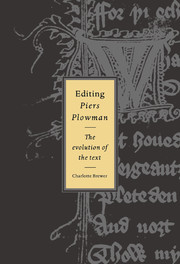Book contents
- Frontmatter
- Contents
- Acknowledgements
- Abbreviations
- Note on the texts
- Introduction
- Part I The early phase
- Part II The late nineteenth century
- 5 The Early English Text Society and its editorial context
- 6 Skeat: introduction
- 7 Skeat's A-Text
- 8 Skeat's B-Text
- 9 Skeat's C-Text
- Part III The Skeat aftermath
- Part IV Chambers and Grattan, Knott and Fowler
- Part V The Athlone Press edition
- Part VI Epilogue: the Athlone aftermath: Schmidt, Pearsall, Rigg-Brewer, et al.
- Works cited
- General index
- Index of manuscripts
- CAMBRIDGE STUDIES IN MEDIEVAL LITERATURE
9 - Skeat's C-Text
Published online by Cambridge University Press: 20 August 2009
- Frontmatter
- Contents
- Acknowledgements
- Abbreviations
- Note on the texts
- Introduction
- Part I The early phase
- Part II The late nineteenth century
- 5 The Early English Text Society and its editorial context
- 6 Skeat: introduction
- 7 Skeat's A-Text
- 8 Skeat's B-Text
- 9 Skeat's C-Text
- Part III The Skeat aftermath
- Part IV Chambers and Grattan, Knott and Fowler
- Part V The Athlone Press edition
- Part VI Epilogue: the Athlone aftermath: Schmidt, Pearsall, Rigg-Brewer, et al.
- Works cited
- General index
- Index of manuscripts
- CAMBRIDGE STUDIES IN MEDIEVAL LITERATURE
Summary
Skeat's edition of C is altogether more circumspect. He begins with a recapitulation and expansion of some of the material first presented in the previous two editions, noting that ‘the C-Text MSS. require peculiar care’. This includes an analysis of the five different forms in which Piers Plowman manuscripts are found, and a discussion of the poem's date and order of composition. Here he appeals straightforwardly to common-sense intuition:
it is … as well to shew, first of all, that the C-text is really later than the B-text; in other words, that no mistake has been made in the order of the recensions of the poem. On this point the internal evidence is most conclusive; given the B-text, it is not difficult to see how the C-text was formed from it, by various omissions, additions, transpositions, and corrections. But it is hardly possible to turn the C-text into the B-form, without the most improbable and contradictory suppositions. The transition in the one direction is simple and natural, but in the other direction is difficult and unlikely. This will appear so clearly upon a careful perusal of the two texts that it is hardly worth while to go into particulars.
(C-Text, p. xi)And he explains that the only reason for raising the question at all is that Whitaker had suggested the reverse, that B came after C. ‘This may’, Skeat comments, ‘in some measure account for the difficulty which he had in seeing his way clearly, and for the extraordinary views, founded upon no premises whatsoever, which he formed respecting the respective merits of the two versions.’
- Type
- Chapter
- Information
- Editing Piers PlowmanThe Evolution of the Text, pp. 159 - 178Publisher: Cambridge University PressPrint publication year: 1996

